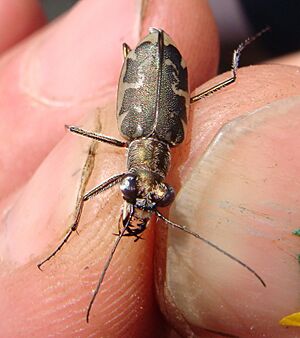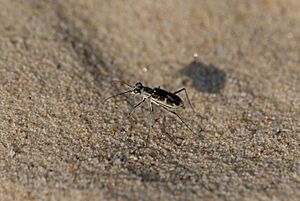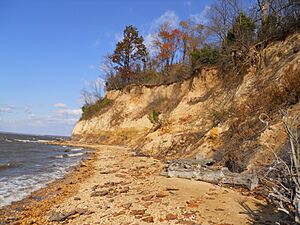Puritan tiger beetle facts for kids
Quick facts for kids Puritan tiger beetle |
|
|---|---|
 |
|
| Scientific classification | |
| Genus: |
Ellipsoptera
|
| Species: |
puritana
|
| Synonyms | |
|
|
The puritan tiger beetle (scientific name: Ellipsoptera puritana) is a cool, flashy beetle. It belongs to the Cicindelidae family, also known as tiger beetles. You can find this beetle in North America. It lives on sandy beaches and rocky cliffs along rivers. These special places are in Massachusetts, Maryland, and Connecticut. Not much is known about this beetle. This is because it lives in only a few places. Also, its numbers are quickly getting smaller.
Contents
What Does the Puritan Tiger Beetle Look Like?
The Puritan tiger beetle is a medium-sized beetle. It lives on land, so it's a terrestrial animal. When it's fully grown, it can be up to 0.56 inches long. That's about half an inch!
This insect has long black legs. It uses them to chase after its food. Its wings can be a bronze-brown color or even green. The underside of its body is a shiny metallic blue. It also has small, white hairs there.
A special thing about the puritan tiger beetle is its big, bulging eyes. But what really makes it stand out is the cream-white pattern on its wing covers. This pattern outlines the edges of its wings. Compared to other beetles, it looks thinner and sleeker. It's also faster because it takes longer steps. These beetles are usually shinier than other types of tiger beetles.
How the Puritan Tiger Beetle Lives
What Do Puritan Tiger Beetles Eat?
The Puritan tiger beetle is a hunter. It eats many small creatures. Its diet includes amphipods, which are tiny shrimp-like animals. It also eats beach arthropods, flies, lice, fleas, and ants. Basically, it preys on small invertebrates, which are animals without backbones.
Where Do Puritan Tiger Beetles Live?
The Puritan tiger beetle lives in wet areas on land. This includes rivers, streams, creeks, and even waterfalls. Its home changes a bit depending on where it is found. New England and Maryland have different environments.
In Maryland, you can find this beetle along a 26-mile stretch of sandy beaches. These beaches are backed by cliffs along the Chesapeake Bay. But in Connecticut and Massachusetts, this beetle likes black sandy beaches more.
Where Can You Find Puritan Tiger Beetles?
The Puritan tiger beetle is found in only three states. In Massachusetts, it lives in just one county: Hampshire County. This is in the middle-western part of the state.
In Connecticut, it's only in Middlesex County. This county is along the southern coast. In Maryland, you can find it in Calvert and Cecil-Kent counties. These are along the shoreline of the Chesapeake Bay. The groups of beetles in New England and Maryland are far apart. They are separated by over 600 miles of land.
How Do Puritan Tiger Beetles Behave?
The behavior of the Puritan tiger beetle changes based on where it lives. In Connecticut and Massachusetts, the beetles look for food along the water's edge. They search in the sandy parts of beaches and rivers.
In Maryland, these beetles prefer narrow, sandy beaches. They look for arthropods and small dead invertebrates there. Puritan tiger beetles are called invertivores. This means they eat invertebrates. They hunt small Diptera (flies) and other arthropods. They also eat dead crustaceans (like crabs) and fish.
Adult beetles and young larvae behave differently. Both hunt small arthropods. But adults grab their prey with their jaws. This is like a "tiger-like" move. Larvae live in burrows in the ground. They use hooks on their sides to hold onto the burrow entrance. This helps them quickly catch their prey.
The Puritan Tiger Beetle Life Cycle
The Puritan tiger beetle has a two-year life cycle. Adult beetles come out of the cliffs in mid-to-late July. Female beetles lay their eggs by mid-August. They lay them on the edges of the beach. All adult beetles die before the end of August.
The larvae hatch by early September. They then make and live in burrows on the beach. Here, they eat small invertebrates for about 22 months. In the second May after hatching, the larvae turn into pupae. The new adult beetles then come out by the end of June.
Adults are about 0.46 to 0.56 inches long when they are two years old. This is when they can start having babies. In the wild, a female usually has one healthy baby before she dies. But if raised by humans, females can have over 100 babies!
Protecting the Puritan Tiger Beetle
Past and Current Population Sizes
The number of Puritan tiger beetles has changed over time. In Calvert County, Maryland, the population was highest in 1998. There were almost 10,000 beetles then. But the Sassafras River population dropped below 500 in the early 2000s.
In Connecticut, the population was highest around 2012, with about 1,600 beetles. At Rainbow Beach, Massachusetts, the highest count was about 80 beetles in 2008.
A survey in 2018 looked at all populations. The Calvert County population had fallen to about 2,000. The Sassafras River population had grown to about 3,500. The Connecticut groups were around 600 beetles. At Rainbow Beach in Massachusetts, there were about 60 beetles.
Where They Live Now
The areas where Puritan tiger beetles live have stayed mostly the same. This includes populations in the Chesapeake Bay and along the Connecticut River. The number of beetles in these areas goes up and down. But overall, the trend has been a decline in recent years.
What Threatens Puritan Tiger Beetles?
Many things threaten the Puritan tiger beetle. Building along shorelines and adding buffers (like walls) has destroyed sandy beaches. This reduces the beetle's home. A plan from 1993 said that dams built on the Connecticut River have changed the water flow. This has hurt the beach habitat.
City growth and bank stabilization (making riverbanks stronger) have also harmed beach sites. This is true in Connecticut and Massachusetts. In Maryland, a wingless wasp called Methocha is a threat. This wasp attacks young beetle larvae. Also, the Maryland population has to compete with another tiger beetle species, Cicindela repanda.
How They Are Protected
The Puritan tiger beetle was first listed as endangered in 1996 by the IUCN Red List. It was listed as threatened under the Endangered Species Act in August 1990. This means it gets special protection. Its scientific name was updated in 2021 to Ellipsoptera puritana. This change became official in January 2022.
The government checks on the beetle every five years. The most recent check was in 2019. The beetle's recovery number stayed at 5C. This means it faces a high threat. But it might not be able to fully recover.
What the Latest Review Found
The most recent 5-year review was done in 2019. It found two new groups of beetles in the Chesapeake area.
Recovery Plan for the Beetle
A plan was written in 1993 to help the Puritan tiger beetle. Its main goal was to remove the beetle from the endangered list. This plan has not been updated since. The main way to help the beetle is to protect its habitat. This is because losing its home is the biggest threat.
The recovery plan lists four things that need to happen for the beetle to be taken off the endangered list:
- At least six large groups of beetles (500-1000+ adults) and their homes must be protected forever. This is for sites along both sides of the Chesapeake Bay.
- Enough habitat between these groups must be protected. This helps smaller groups and allows beetles to mix their genes. This makes sure the whole population stays strong.
- At least three groups, with two being large (500-1000+ adults), must be kept or started. This is for sites along the Connecticut River. Their homes must also be protected forever.
- There needs to be a good, long-term plan for managing each site. This plan must be based on knowing how the beetles live, how humans affect them, why their numbers are dropping, and their genetics.



